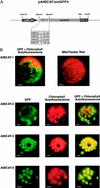The branched-chain amino acid transaminase gene family in Arabidopsis encodes plastid and mitochondrial proteins
- PMID: 12068099
- PMCID: PMC161671
- DOI: 10.1104/pp.001602
The branched-chain amino acid transaminase gene family in Arabidopsis encodes plastid and mitochondrial proteins
Abstract
Branched-chain amino acid transaminases (BCATs) play a crucial role in the metabolism of leucine, isoleucine, and valine. They catalyze the last step of the synthesis and/or the initial step of the degradation of this class of amino acids. In Arabidopsis, seven putative BCAT genes are identified by their similarity to their counterparts from other organisms. We have now cloned the respective cDNA sequences of six of these genes. The deduced amino acid sequences show between 47.5% and 84.1% identity to each other and about 30% to the homologous enzymes from yeast (Saccharomyces cerevisiae) and mammals. In addition, many amino acids in crucial positions as determined by crystallographic analyses of BCATs from Escherichia coli and human (Homo sapiens) are conserved in the AtBCATs. Complementation of a yeast Deltabat1/Deltabat2 double knockout strain revealed that five AtBCATs can function as BCATs in vivo. Transient expression of BCAT:green fluorescent protein fusion proteins in tobacco (Nicotiana tabacum) protoplasts shows that three isoenzymes are imported into chloroplasts (AtBCAT-2, -3, and -5), whereas a single enzyme is directed into mitochondria (AtBCAT-1).
Figures



Similar articles
-
An overview of branched-chain amino acid aminotransferases: functional differences between mitochondrial and cytosolic isozymes in yeast and human.Appl Microbiol Biotechnol. 2021 Nov;105(21-22):8059-8072. doi: 10.1007/s00253-021-11612-4. Epub 2021 Oct 8. Appl Microbiol Biotechnol. 2021. PMID: 34622336 Review.
-
A branched-chain aminotransferase may regulate hormone levels by affecting KNOX genes in plants.Planta. 2009 Sep;230(4):611-23. doi: 10.1007/s00425-009-0973-8. Epub 2009 Jul 1. Planta. 2009. PMID: 19568767
-
The mitochondrial branched-chain aminotransferase (AtBCAT-1) is capable to initiate degradation of leucine, isoleucine and valine in almost all tissues in Arabidopsis thaliana.Plant Mol Biol. 2005 Jan;57(2):241-54. doi: 10.1007/s11103-004-7533-1. Plant Mol Biol. 2005. PMID: 15821880
-
A member of a novel Arabidopsis thaliana gene family of candidate Mg2+ ion transporters complements a yeast mitochondrial group II intron-splicing mutant.Plant J. 2000 Nov;24(4):489-501. doi: 10.1046/j.1365-313x.2000.00895.x. Plant J. 2000. PMID: 11115130
-
Structure and function of branched chain aminotransferases.Prog Nucleic Acid Res Mol Biol. 2001;70:175-206. doi: 10.1016/s0079-6603(01)70017-7. Prog Nucleic Acid Res Mol Biol. 2001. PMID: 11642362 Review.
Cited by
-
New insights in the sugarcane transcriptome responding to drought stress as revealed by superSAGE.ScientificWorldJournal. 2012;2012:821062. doi: 10.1100/2012/821062. Epub 2012 May 2. ScientificWorldJournal. 2012. PMID: 22629208 Free PMC article.
-
Molecular Cloning, Expression Pattern and Genotypic Effects on Glucoraphanin Biosynthetic Related Genes in Chinese Kale (Brassica oleracea var. alboglabra Bailey).Molecules. 2015 Nov 11;20(11):20254-67. doi: 10.3390/molecules201119688. Molecules. 2015. PMID: 26569208 Free PMC article.
-
An overview of branched-chain amino acid aminotransferases: functional differences between mitochondrial and cytosolic isozymes in yeast and human.Appl Microbiol Biotechnol. 2021 Nov;105(21-22):8059-8072. doi: 10.1007/s00253-021-11612-4. Epub 2021 Oct 8. Appl Microbiol Biotechnol. 2021. PMID: 34622336 Review.
-
Branched-Chain Amino Acid Metabolism in Arabidopsis thaliana.Arabidopsis Book. 2010;8:e0137. doi: 10.1199/tab.0137. Epub 2010 Aug 23. Arabidopsis Book. 2010. PMID: 22303262 Free PMC article.
-
Genome-wide association analysis reveals distinct genetic architectures for single and combined stress responses in Arabidopsis thaliana.New Phytol. 2017 Jan;213(2):838-851. doi: 10.1111/nph.14165. Epub 2016 Sep 8. New Phytol. 2017. PMID: 27604707 Free PMC article.
References
-
- Altschul SF, Gish W, Miller W, Myers EW, Lipman DJ. Basic local alignment search tool. J Mol Biol. 1990;215:403–410. - PubMed
-
- Aubert S, Alban C, Bligny R, Douce R. Induction of beta-methylcrotonyl-coenzyme A carboxylase in higher plant cells during carbohydrate starvation: evidence for a role of MCCase in leucine catabolism. FEBS Lett. 1996;383:175–180. - PubMed
-
- Bledsoe RK, Dawson PA, Hutson SM. Cloning of the rat and human mitochondrial branched chain aminotransferases (BCATm) Biochim Biophys Acta. 1997;1339:9–13. - PubMed
Publication types
MeSH terms
Substances
Associated data
- Actions
- Actions
- Actions
- Actions
- Actions
- Actions
LinkOut - more resources
Full Text Sources
Molecular Biology Databases

